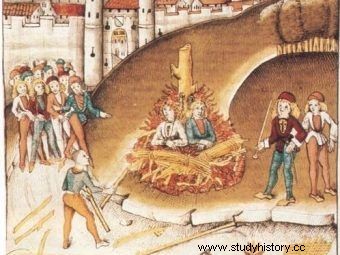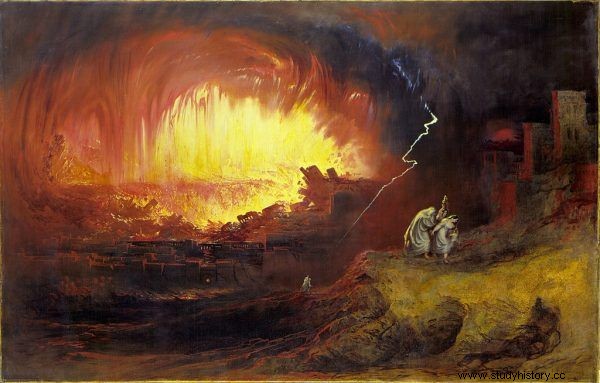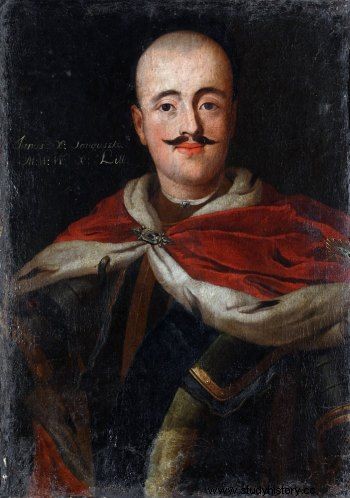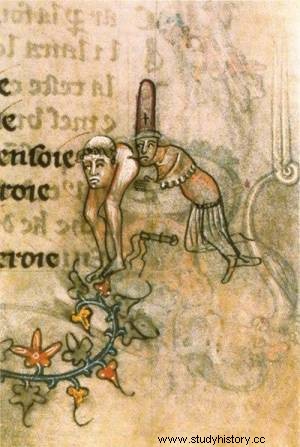Until recently, it was widely believed that there were no homosexuals in old Poland. However, this view needs to be verified:there are sources that even mention cases of bringing sodomites to trial and punishing them with death. The only question is:what exactly was meant by "sodomy"?
We should start with the fact that in the code "Constitutio Criminalis Carolina" written by Emperor Charles V, later adapted by the lawyer Bartłomiej Groicki and implemented in Polish realities, homosexuals were to be punished with death. The problem is that homosexuality has not been distinguished from a series of perversions such as zoophilia, for example, putting all non-heterosexual persons into one bag.

In the past, the concept of sodomy was unfairly broad
Wherever there should be such a man, so that the peasant and the peasant should have a case against nature, they are to be punished on their throats, and according to the custom they should be burned with fire, without all mercy and grace, because it is a heinous and disgraceful sin and is to be severely punished
- we read in the sixteenth century recipes. Interestingly, despite the strict law, it seems that there were relatively few cases of homosexuality ended with execution compared to, for example, zoophilia or rape ...
The Sieradz process
Interestingly, the conviction that homosexuals have no criminal record in Poland persists even in scientific studies.
In Poland, homosexuality has never been punishable (which does not mean that the society approved it, although from the tenor of the narrative sources we know it was tolerant of homosexuals), homosexuals were never prosecuted, they were never imprisoned so there was no reason to document it
- we read in the article in Przegląd Historyczny from 2007. Meanwhile, the sodomy laws weren't quite dead…

The Destruction of Sodom and Gomorrah, John Martin, 1832
The most famous case of a homosexual couple sentenced to death in Poland is the Sieradzki Trial in 1633. At that time, the bakery master, Marcin Gołek, had secret relations with his student, Wojciech from Sromotka - in summer outside the city walls, and in winter in secluded urban nooks.
According to Wojciech's testimony, his master enslaved him under the influence of alcohol and then paid for his silence. It all came to light when the baker revealed intimate secrets to the hostess. Young Wojciech then began to accuse Marcin in court, standing in the position of the prosecutor ... But he quickly became an accomplice himself.
Marcin, testifying before the judge, described how the student had persuaded him to engage in abusive relations. Wojciech was supposed to mate with animals on the pasture earlier. The latter, of course, denied everything, stubbornly claiming that the master was forcing him into intercourse. There was no conclusion, so the court sentenced both men as complicit in sodomy. They were burned at the stake on November 9, 1633.
What is allowed the nobility…
The deeds which could lead a common person to the stake passed away freely to the nobility. The case of Prince Janusz Aleksander Sanguszko's numerous affairs with young boys, whom he gave generously with gifts, is quite well known. One of them, Kazimierz Chyliński, was sentenced to 12 years in prison for intercourse with the prince. Since then, Sanguszka has no longer flaunted with his lovers.

Janusz Aleksander Sanguszko was to have many lovers
Information on noble homosexuality has been preserved in much less credible sources. While in the case of the Sieradz Trial we are sure that the law has been implemented, the stories of the "maritalism" of a privileged class of society are more of a rumor.
For example, the baroque satirical writer Walerian Nekanda Trepka described many cases of "sodomy" among the gentlemen:Jan Rogoziński, in his opinion, had an affair with the nobleman Jan Andrekas, and Mikołaj Sariusz Miniński devoted himself to Mr. Piotr Krzysztof; "He communed with them in posticum in Turkish, and France acquired him."
Sodomy has more than one name
As we indicated at the beginning - in Poland, the legislation did not distinguish between homosexual behavior and real deviations, and the concept of sodomy has unfortunately become extremely broad. In the 1840s, as we learn from "Hultajów, villains, harlots in old Krakow", many people were convicted of sodomy. The letter of the law was still the same ("[...] they are to be burned with fire, without any mercy or grace"), and the sentences were carried out, as evidenced by the entries in the city bills.
Quite an interesting case of a judged and murdered pervert was Jan Witkowski from Wolbórz, who, most likely at the instigation of his confessor, himself reported to the town hall to be judged. He testified that
with a little girl, maybe twelve years old, I had a corporeal deed [...], then maybe thirty or forty times I had the same deed with chickens, even once with a goose [...], having the lust of my body, so with a dog I had a condemnation [...] a corporeal act maybe twelve times or more, which no one saw, also in Piotrków with a pig, once also with a sheep [...], with a cat there I wanted to have a corporeal matter and put my naturalia in its mouth, but the effect was nullus , also with a squirrel.

Templar kissing the clergyman
Of course, the death wish on the part of the sodomites was fulfilled by the court.
While several similar cases have been recorded in history, we will not find any more trials for homosexuality. Manifestations of such sexual preferences were of course treated reluctantly and publicly criticized (most often from the church pulpit), but there was no repetition of the Sieradzki Trial.
The question remains, where exactly did the widespread aversion to homosexuality come from? After all, it did not always exist, it only spread in the Middle Ages.
In the thirteenth century, the increasing acceptance of sexual intercourse within marriage goes hand in hand with the development and clarification of legal and canonical norms against sexual "crimes". Then one should look for the sources of modern aversion to coexistence contra naturam, including homosexual behavior
- explains Skwierczyński in an article in Przegląd Historyczny.
Nowadays, sex is understood as a phenomenon occurring between two people, while in the medieval culture a very important division into the active (male) and passive (female) side was very important - therefore homosexual relations were dangerous for society because they disturbed this binary division. The primary medieval distinction between "good" and "bad" sexual act is the distinction between reproductive and non-reproductive sex.
Bibliography:
- Kracik, J., Rożek, M., Hultaje, villains, harlots in old Krakow. On the social margin of the 16th - 18th centuries. Wydawnictwo Literackie, Kraków, 1986.
- Skwierczyński, K., Vademecum of Medieval Sexuality. Historical Review 98/3, Polish History Museum, 2007.
- Wolnicka, A., Mężolubnicy i samcołożnicy. What do we know about homosexuals in old Poland? Tytus, 8/10/2018, accessed:22/07/2020.
- Wyrobisz, A., Tolerance, intolerance and superstitions in medieval and modern Europe. Research on the history of homosexuality, the attitude of society towards homosexuals and the participation of homosexuals in culture. University of Warsaw, Przegląd Historyczny, 2007.
